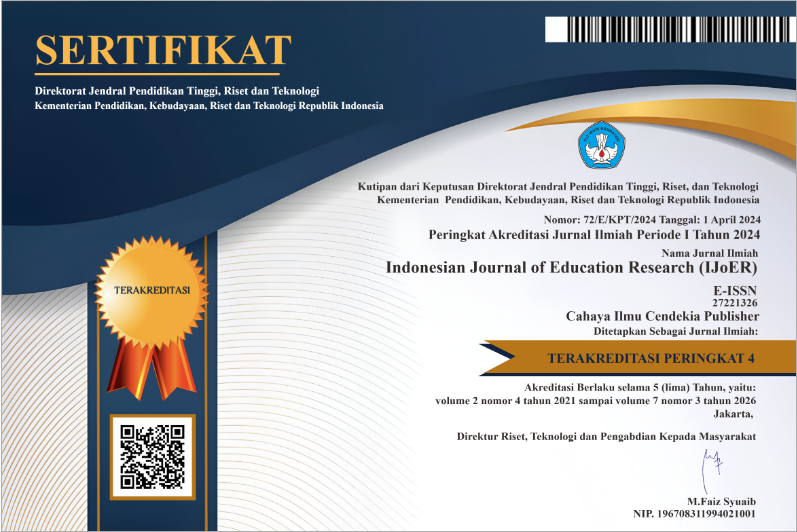The Effect of Scaffolding Using the Peer Tutoring Method on Biology Learning Outcomes in the Material of the Human Excretory System
Abstract
Purpose of the study: To find out the effect of scaffolding using the peer tutoring learning method on the cognitive, affective and psychomotor aspects of class IX students of SMP Negeri 1 Muaro Jambi on the subject of the excretory system in humans.
Methodology: This type of research is a real experiment or true experiment. While the research design used in this study is the Posttest-Only Control Design. The sample in this study was class IX A as the experimental class and class IX D as the control class. The types of data and data sources in this study are quantitative data obtained from the results of tests carried out or data that describe cognitive aspects and qualitative data, namely data obtained from affective and psychomotor aspects. The instrument used for assessing learning outcomes in the cognitive aspect is a written test. Multiple choice questions are used for the posttest in the experimental class and the control class. For the assessment of learning outcomes on the affective aspect a questionnaire was used, and for the assessment of learning outcomes on the psychomotor aspect a worksheet was used for students.
Main Findings: Scaffolding (providing assistance) using the Peer Tuthoring learning method does not affect the learning outcomes of biology in class IX students of SMP Negeri 1 Muara Jambi in the cognitive aspect, but affects the affective and psychomotor aspects.
Novelty/Originality of this study: It can be used as material for consideration and information for teachers in selecting appropriate, effective, and efficient learning models in the biology learning process. So that it can improve student learning outcomes in Biology subjects.
References
N. R. Sari and Y. Yulhendri, “Pengaruh Peran Guru Dalam Proses Pembelajaran dan Intensitas Belajar Terhadap Hasil Belajar Siswa Kelas X IPS SMA Negeri 5 Padang Pada Mata Pelajaran Ekonomi Tahun Ajaran 2018/2019,” J. Ecogen, vol. 3, no. 1, p. 61, 2020, doi: 10.24036/jmpe.v3i1.8526.
M. Muammar and S. Suhartina, “Media Pembelajaran Berbasis Teknologi Informasi dalam Meningkatkan Minat Belajar Akidah Akhlak,” KURIOSITAS Media Komun. Sos. dan Keagamaan, vol. 11, no. 2, pp. 176–188, 2018, doi: 10.35905/kur.v11i2.728.
Susiyati, “Pembelajaran Reciprocal Teaching Model dengan Strategi Motivasi ARCS mampu Meningkatkan Hasil dan Kemandirian Belajar Siswa Kelas XI PMS 2 SMKN 1 Lumajang,” Educazione, vol. 6, no. 2, pp. 5–24, 2018.
Muliati, “Meningkatkan Aktivitas Dan Hasil Belajar Pkn Materi Pilkada Melalui Model Pembelajaran Reciprocal Teaching Siswa Kelas Vi Sdn Sungai Rumbia Tahun Pelajaran 2017/2018 Muliati,” J. Langsat, vol. 5, no. 2, pp. 63–74, 2018.
M. T. W. Widhi, A. R. Hakim, N. I. Wulansari, M. I. Solahuddin, and S. Admoko, “Analisis Keterampilan Argumentasi Ilmiah Peserta Didik Pada Model Pembelajaran Berbasis Toulmin’s Argumentation Pattern (TAP) Dalam Memahami Konsep Fisika Dengan Metode Library Research,” PENDIPA J. Sci. Educ., vol. 5, no. 1, pp. 79–91, 2021, doi: 10.33369/pendipa.5.1.79-91.
S. Kamelia and H. Pujiastuti, “Penerapan Strategi Pembelajaran Metakognitif-Scaffolding untuk Meningkatkan Kemampuan Pemecahan Masalah Matematis dan Self Regulated Learning Siswa,” JURING (Journal Res. Math. Learn., vol. 3, no. 4, p. 385, 2020, doi: 10.24014/juring.v3i4.9454.
N. W. Damayanti, “Praktik Pemberian Scaffolding oleh Mahasiswa Pendidikan Matematika Pada Mata Kuliah Strategi Belajar Mengajar (SBM) Matematika,” LIKHITAPRAJNA J. Ilm. Fak. Kegur. dan Ilmu Pendidik., vol. 18, no. 1, pp. 85–95, 2016.
U. S. Sidin, “Penerapan Strategi Scaffolding Pada Pembelajaran Pemrograman Web Di Smk Kartika Wirabuana 1,” J. Publ. Pendidik., vol. 6, no. 3, pp. 187–195, 2016, doi: 10.26858/publikan.v6i3.2274.
S. Kusanti, “Peningkatan Pemahaman Konsep Sistem Koordinat Melalui Metode Tutor Sebaya Pada Siswa Kelas VI SDN Bendogerit 2 Kota Blitar,” IJOIS Indones. J. Islam. Stud., vol. 3, no. 02, pp. 205–217, 2022.
K. Kamar, M. Asbari, A. Purwanto, W. Nurhayati, and R. N. Sudiyono, “Membangun Karakter Siswa Sekolah Dasar Melalui Prakter Pola Asuh Orang Tua Berdasarkan Genetic Personality,” J. Inov. Pembelajaran, vol. 6, no. c, pp. 75–86, 2020.
N. P. Anggorowati, “Penerapan Model Pembelajaran Tutor Sebaya Pada Mata Pelajaran Sosiologi,” KOMUNITAS Int. J. Indones. Soc. Cult., vol. 3, no. 1, pp. 103–120, 2011, doi: 10.15294/komunitas.v3i1.2303.
A. P. Munthe and H. P. Naibaho, “Manfaat dan Kendala Penerapan Tutor Sebaya untuk Siswa Kelas IV Sekolah Dasar Lentera Harapan Mamit,” Sch. J. Pendidik. dan Kebud., vol. 9, no. 2, pp. 138–147, 2019, doi: 10.24246/j.js.2019.v9.i2.p138-147.
Copyright (c) 2023 Widia Astuti, Marta H Sianipar

This work is licensed under a Creative Commons Attribution-NonCommercial 4.0 International License.
Authors who publish with this journal agree to the following terms:
- Authors retain copyright and acknowledge that the Indonesian Journal of Education Research (IJoER) is the first publisher licensed under a Creative Commons Attribution 4.0 International License.
- Authors are able to enter into separate, additional contractual arrangements for the non-exclusive distribution of the journal's published version of the work (e.g., post it to an institutional repository or publish it in a book), with an acknowledgment of its initial publication in this journal.
- Authors are permitted and encouraged to post their work online (e.g., in institutional repositories or on their website) prior to and during the submission process, as it can lead to productive exchanges and earlier and greater citation of published work.






.png)
.png)




















